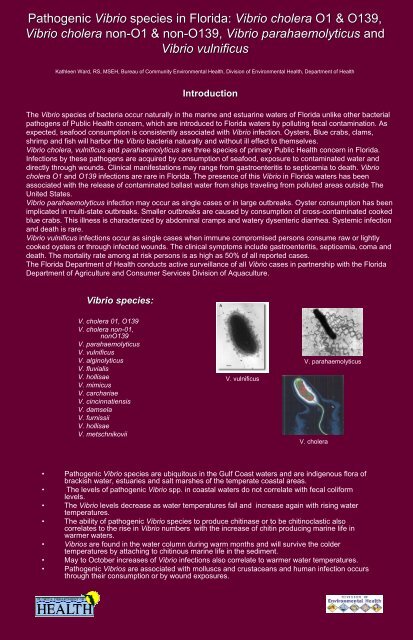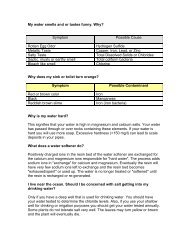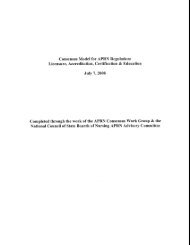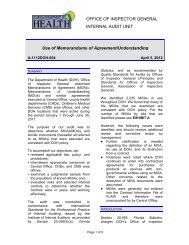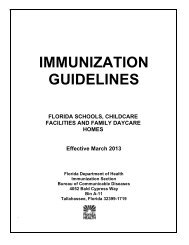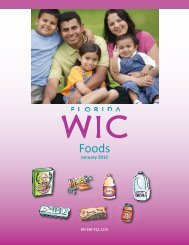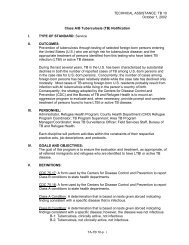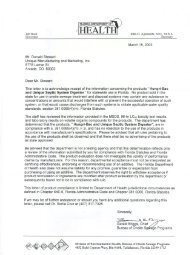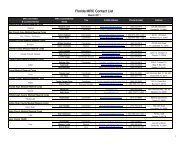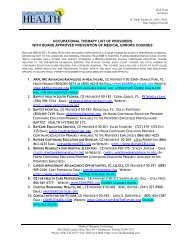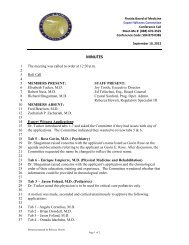Pathogenic Vibrio species in Florida - Florida Department of Health
Pathogenic Vibrio species in Florida - Florida Department of Health
Pathogenic Vibrio species in Florida - Florida Department of Health
Create successful ePaper yourself
Turn your PDF publications into a flip-book with our unique Google optimized e-Paper software.
<strong>Pathogenic</strong> <strong>Vibrio</strong> <strong>species</strong> <strong>in</strong> <strong>Florida</strong>: <strong>Vibrio</strong> cholera O1 & O139,<br />
<strong>Vibrio</strong> cholera non-O1 non O1 & non-O139, non O139, <strong>Vibrio</strong> parahaemolyticus and<br />
<strong>Vibrio</strong> vulnificus<br />
Kathleen Ward, RS, MSEH, Bureau <strong>of</strong> Community Environmental <strong>Health</strong>, Division <strong>of</strong> Environmental <strong>Health</strong>, <strong>Department</strong> <strong>of</strong> <strong>Health</strong><br />
Introduction<br />
The <strong>Vibrio</strong> <strong>species</strong> <strong>of</strong> bacteria occur naturally <strong>in</strong> the mar<strong>in</strong>e and estuar<strong>in</strong>e waters <strong>of</strong> <strong>Florida</strong> unlike other bacterial<br />
pathogens <strong>of</strong> Public <strong>Health</strong> concern, which are <strong>in</strong>troduced to <strong>Florida</strong> waters by pollut<strong>in</strong>g fecal contam<strong>in</strong>ation. As<br />
expected, seafood consumption is consistently associated with <strong>Vibrio</strong> <strong>in</strong>fection. Oysters, Blue crabs, clams,<br />
shrimp and fish will harbor the <strong>Vibrio</strong> bacteria naturally and without ill effect to themselves.<br />
<strong>Vibrio</strong> cholera, vulnificus and parahaemolyticus are three <strong>species</strong> <strong>of</strong> primary Public <strong>Health</strong> concern <strong>in</strong> <strong>Florida</strong>.<br />
Infections by these pathogens are acquired by consumption <strong>of</strong> seafood, exposure to contam<strong>in</strong>ated water and<br />
directly through wounds. Cl<strong>in</strong>ical manifestations may range from gastroenteritis to septicemia to death. <strong>Vibrio</strong><br />
cholera O1 and O139 <strong>in</strong>fections are rare <strong>in</strong> <strong>Florida</strong>. The presence <strong>of</strong> this <strong>Vibrio</strong> <strong>in</strong> <strong>Florida</strong> waters has been<br />
associated with the release <strong>of</strong> contam<strong>in</strong>ated ballast water from ships travel<strong>in</strong>g from polluted areas outside The<br />
United States.<br />
<strong>Vibrio</strong> parahaemolyticus <strong>in</strong>fection may occur as s<strong>in</strong>gle cases or <strong>in</strong> large outbreaks. Oyster consumption has been<br />
implicated <strong>in</strong> multi-state outbreaks. Smaller outbreaks are caused by consumption <strong>of</strong> cross-contam<strong>in</strong>ated cooked<br />
blue crabs. This illness is characterized by abdom<strong>in</strong>al cramps and watery dysenteric diarrhea. Systemic <strong>in</strong>fection<br />
and death is rare.<br />
<strong>Vibrio</strong> vulnificus <strong>in</strong>fections occur as s<strong>in</strong>gle cases when immune compromised persons consume raw or lightly<br />
cooked oysters or through <strong>in</strong>fected wounds. The cl<strong>in</strong>ical symptoms <strong>in</strong>clude gastroenteritis, septicemia, coma and<br />
death. The mortality rate among at risk persons is as high as 50% <strong>of</strong> all reported cases.<br />
The <strong>Florida</strong> <strong>Department</strong> <strong>of</strong> <strong>Health</strong> conducts active surveillance <strong>of</strong> all <strong>Vibrio</strong> cases <strong>in</strong> partnership with the <strong>Florida</strong><br />
<strong>Department</strong> <strong>of</strong> Agriculture and Consumer Services Division <strong>of</strong> Aquaculture.<br />
<strong>Vibrio</strong> <strong>species</strong>:<br />
V. cholera 01, O139<br />
V. cholera non-01,<br />
nonO139<br />
V. parahaemolyticus<br />
V. vulnificus<br />
V. alg<strong>in</strong>olyticus<br />
V. fluvialis<br />
V. hollisae<br />
V. mimicus<br />
V. carchariae<br />
V. c<strong>in</strong>c<strong>in</strong>natiensis<br />
V. damsela<br />
V. furnissii<br />
V. hollisae<br />
V. metschnikovii<br />
V. vulnificus<br />
V. parahaemolyticus<br />
V. cholera<br />
• <strong>Pathogenic</strong> <strong>Vibrio</strong> <strong>species</strong> are ubiquitous <strong>in</strong> the Gulf Coast waters and are <strong>in</strong>digenous flora <strong>of</strong><br />
brackish water, estuaries and salt marshes <strong>of</strong> the temperate coastal areas.<br />
• The levels <strong>of</strong> pathogenic <strong>Vibrio</strong> spp. <strong>in</strong> coastal waters do not correlate with fecal coliform<br />
levels.<br />
• The <strong>Vibrio</strong> levels decrease as water temperatures fall and <strong>in</strong>crease aga<strong>in</strong> with ris<strong>in</strong>g water<br />
temperatures.<br />
• The ability <strong>of</strong> pathogenic <strong>Vibrio</strong> <strong>species</strong> to produce chit<strong>in</strong>ase or to be chit<strong>in</strong>oclastic also<br />
correlates to the rise <strong>in</strong> <strong>Vibrio</strong> numbers with the <strong>in</strong>crease <strong>of</strong> chit<strong>in</strong> produc<strong>in</strong>g mar<strong>in</strong>e life <strong>in</strong><br />
warmer waters.<br />
• <strong>Vibrio</strong>s are found <strong>in</strong> the water column dur<strong>in</strong>g warm months and will survive the colder<br />
temperatures by attach<strong>in</strong>g to chit<strong>in</strong>ous mar<strong>in</strong>e life <strong>in</strong> the sediment.<br />
• May to October <strong>in</strong>creases <strong>of</strong> <strong>Vibrio</strong> <strong>in</strong>fections also correlate to warmer water temperatures.<br />
• <strong>Pathogenic</strong> <strong>Vibrio</strong>s are associated with molluscs and crustaceans and human <strong>in</strong>fection occurs<br />
through their consumption or by wound exposures.
<strong>Vibrio</strong> cholera 01 And 0139<br />
•<strong>Vibrio</strong> cholera O1 and O139 produce the cholera tox<strong>in</strong>. Infections are very rare <strong>in</strong> the United States<br />
with usually no more that 0-5 cases per year.<br />
•Transmission occurs through consumption <strong>of</strong> contam<strong>in</strong>ated foods and dr<strong>in</strong>k<strong>in</strong>g water, as well as raw<br />
or undercooked shellfish.<br />
•Incubation periods ranges from hours to 5 days, usually average 2-3 days.<br />
•Many <strong>in</strong>fections are asymptomatic or have milder diarrhea. Serious <strong>in</strong>fections exhibit pr<strong>of</strong>use watery<br />
diarrhea, vomit<strong>in</strong>g, circulatory collapse and shock. 25-50% are fatal if untreated.<br />
•Treatment <strong>in</strong>cludes; aggressive rehydration therapy, adm<strong>in</strong>istration <strong>of</strong> effective antibiotics (which<br />
also helps to shorten the period <strong>of</strong> communicability) and treatment <strong>of</strong> complications<br />
<strong>Vibrio</strong> cholera non-01 non 01 and non-0139 non 0139<br />
•<strong>Vibrio</strong> cholera non-O1 and non-O139 stra<strong>in</strong>s rarely produce the cholera tox<strong>in</strong> and do not cause<br />
epidemic disease.<br />
•Transmission also occurs through consumption <strong>of</strong> raw, undercooked or cross-contam<strong>in</strong>ated shellfish<br />
such as oysters and blue crabs. Wound related <strong>in</strong>fections may also occur.<br />
•Incubation periods range from 5 -96 hours but usually average 10 hours.<br />
•Infection usually causes a mild self-limit<strong>in</strong>g gastroenteritis. Although persons with preexist<strong>in</strong>g health<br />
problems are at greater risk for life threaten<strong>in</strong>g <strong>in</strong>fection.<br />
•Serious <strong>in</strong>fections require aggressive and prompt antibiotic therapy.<br />
<strong>Vibrio</strong> parahaemolyticus<br />
<strong>Vibrio</strong> parahaemolyticus is responsible for an estimated 3000 cases, an average <strong>of</strong> 190 culture<br />
confirmed cases, 40 hospitalizations and 7 deaths <strong>in</strong> the United States each year.<br />
Transmission is most commonly associated with consumption <strong>of</strong> raw, undercooked or crosscontam<strong>in</strong>ated<br />
shellfish and crustaceans. There are also <strong>in</strong>fections through wound or s<strong>of</strong>t<br />
tissue exposures.<br />
Large outbreaks <strong>of</strong> <strong>Vibrio</strong> parahaemolyticus <strong>in</strong>fections are <strong>of</strong>ten associated with raw oyster<br />
consumption. Smaller outbreaks or <strong>in</strong>dividual cases are commonly associated with<br />
consumption <strong>of</strong> cooked Blue crab that has been mishandled.<br />
<strong>Vibrio</strong> parahaemolyticus is a relatively fragile microbe and is readily destroyed by normal cook<strong>in</strong>g<br />
temperatures. Live <strong>Vibrio</strong> parahaemolyticus organisms are re<strong>in</strong>troduced to susceptible<br />
foods such as cooked Blue crabs by cross contam<strong>in</strong>ation from Live crabs or contam<strong>in</strong>ated<br />
surfaces. Also improper temperature management such as failure to ma<strong>in</strong>ta<strong>in</strong> hot hold<strong>in</strong>g<br />
temperatures or too rapidly chill cooked crabs is <strong>of</strong>ten implicated <strong>in</strong> outbreaks.<br />
Incubation periods for <strong>Vibrio</strong> parahaemolyticus range from 4-30 hours and usually average 12-24<br />
hours.<br />
Symptoms <strong>in</strong>clude nausea, vomit<strong>in</strong>g, cramps, fever and watery, sometimes bloody diarrhea.<br />
Duration <strong>of</strong> the illness usually only lasts 2-3 days with no long term health effects. Immunecompromised<br />
persons are at greater risk for more serious illness and complications.
<strong>Vibrio</strong> parahaemolyticus and blue crabs, Duval County, 1995, 1997,1999, 2000,<br />
2003 and 2004<br />
•3 Jacksonville seafood markets also operat<strong>in</strong>g as take out restaurants have multiple <strong>Vibrio</strong><br />
parahaemolyticus outbreaks between 1995-2004:<br />
•Cross Contam<strong>in</strong>ation Nightmare: Crabs contam<strong>in</strong>ated after cook<strong>in</strong>g by; contact with Live crabs <strong>in</strong><br />
the display cooler, food contact surfaces (sheet pans) contam<strong>in</strong>ated with raw crab water and<br />
be<strong>in</strong>g stored <strong>in</strong> baskets that held live crabs.<br />
•Temperature Abuse Nightmare: Hot cooked crabs are packed <strong>in</strong> styr<strong>of</strong>oam boxes <strong>in</strong>stead <strong>of</strong> be<strong>in</strong>g<br />
rapidly chilled before packag<strong>in</strong>g. Boxes <strong>of</strong> Hot product are stacked top to bottom and front to rear<br />
<strong>of</strong> an old display cooler.<br />
•Overloaded display cooler unable to accomplish rapid chill<strong>in</strong>g to safe temperatures. Temperature<br />
checks dur<strong>in</strong>g <strong>in</strong>vestigation showed that boxes <strong>in</strong> the middle <strong>of</strong> the stacked products were still<br />
above 50f after 24 hours <strong>in</strong> the cooler.<br />
•Leftover cooked crabs from consumers and stool samples were positive for <strong>Vibrio</strong> parahaemolyticus.<br />
2004 outbreak samples results from crab and stools were also positive for <strong>Vibrio</strong> alg<strong>in</strong>olyticus and<br />
suspected positive for <strong>Vibrio</strong> cholera nonO1.<br />
<strong>Vibrio</strong> vulnificus<br />
• Among the pathogenic <strong>Vibrio</strong> <strong>species</strong>, <strong>Vibrio</strong> vulnificus causes the most severe disease. The septicemia<br />
and wound <strong>in</strong>fections caused by this pathogen progress rapidly and are frequently fatal.<br />
• An average <strong>of</strong> 50 culture-confirmed cases, 45 hospitalizations and 16 deaths are reported each year<br />
from the Gulf Coast region. Nationwide there are 95 cases, 85 hospitalizations and 35 deaths.<br />
• Consumption <strong>of</strong> raw oysters (as few as 3) is the predom<strong>in</strong>ant source <strong>of</strong> systemic <strong>Vibrio</strong> vulnificus<br />
<strong>in</strong>fection. Serious <strong>in</strong>fections also occur through wound or s<strong>of</strong>t tissue exposures to warm estuar<strong>in</strong>e<br />
waters.<br />
• Incubation periods range from 12-72 hours after exposure.<br />
• Symptoms <strong>in</strong> otherwise healthy persons <strong>in</strong>clude vomit<strong>in</strong>g, diarrhea and abdom<strong>in</strong>al pa<strong>in</strong>. Persons with<br />
underly<strong>in</strong>g medical conditions experience fever, chills, decreased blood pressure, blister<strong>in</strong>g sk<strong>in</strong> lesions,<br />
shock, and death.<br />
• Individuals at highest risk for serious or fatal <strong>in</strong>fections are those with cirrhosis, other liver disease,<br />
hemochromatosis, chronic liver disease and those immunocompromised by underly<strong>in</strong>g disease such as<br />
diabetes or by medications.<br />
• The typical case is a 40-75 year old male, heavy dr<strong>in</strong>ker, unaware <strong>of</strong> or <strong>in</strong> denial <strong>of</strong> dietary risks who<br />
consumes raw or undercooked oysters and suffers septicemia with a 50% mortality rate.<br />
Number <strong>of</strong> Cases/Deaths<br />
18<br />
16<br />
14<br />
12<br />
10<br />
8<br />
6<br />
4<br />
2<br />
0<br />
1988<br />
1989<br />
<strong>Vibrio</strong> vulnificus Cases and Deaths Associated With Oyster<br />
Consumption,<br />
<strong>Florida</strong>, 1988-2003<br />
1990<br />
1991<br />
1992<br />
1993<br />
1994<br />
1995<br />
1996<br />
Year<br />
1997<br />
1998<br />
1999<br />
2000<br />
2001<br />
2002<br />
From 1988-2003, 157 cases from oyster consumption, 71 deaths – 45% cases died.<br />
References<br />
• Tyson, David L., <strong>Vibrio</strong> 29: pp 497-506, Manual <strong>of</strong> Cl<strong>in</strong>ical Microbiology 7 th ed., 1999.<br />
• Michael P. Doyle, ed. Foodborne Bacterial Pathogens, 1989, pp. 525-597.<br />
• James Ch<strong>in</strong>, ed. Control <strong>of</strong> Communicable Diseases Manual, 17 th edition, 2000 American<br />
Public <strong>Health</strong> Association, pp. 100-115.<br />
• CDC Diseases and Conditions: http://www.cdc.gov/az.do/id/0900f3ec8000e035#V<br />
2003<br />
Cases<br />
Deaths


